
Red dots sights (RDS) on handguns have been around competitive shooting, SWAT teams, and special military units for decades. They provide significant advantages to shooters, but the more time you have on iron sights, the harder it is to change. If you understand the way your eyes work with RDS, you can make your transition shorter and smoother.
There are many advantages to RDS on handguns, but it does not pull the trigger for you. Anticipation of recoil will still move the barrel off target at the last second and poor stance and grip will fail under the recoil of multiple shots. All the fundamentals still apply. If you can’t shoot a group with irons, don’t expect anything different with RDS.
I would never force a competent shooter to leave iron sights if they were uncomfortable with RDS. Many shooters don’t want to invest time learning a new system. What RDS does do is help you see the sights and the target. For shooters struggling with vision issues, the RDS can provide a simple solution to struggles with visual acuity and dominance and are well worth the effort.
Picking an RDS System
There are many quality RDS sights on the market, but some of the less expensive options will not hold up to the tremendous recoil forces. Do your homework and get a quality model. When you have the sight you want, get a slide with a matching “footprint”. The footprint is the cut or plate that matches the bottom of the slide.
Pay attention to the mounting system. A slide cut with a specific sight footprint at the factory provides the best fit. Slides requiring adapter plates often set the sight higher and can break. If you wish to modify your old slide, find a master craftsman like Brimstone Gunsmithing to do the cut.
An engineer at SIG told me that they carefully measure recoil energy in testing and product development. He has seen initial recoil forces of 13,000 G’s on RDS. This is why mounting is so important.
The mounting screws provided with your sight may be poor quality, the wrong length or wrong threads for your slide and sight combination. They must be torqued to a proper setting and a tread locker is critical. If you don’t know how to do this, go to a pro like Kenny at I5 Guns, my local gunstore.
I know my gear, but when something new comes out, I am back at square one. Find a shop with a guy like Kenny who installs several RDS sights a day including new models and off brands on every model of handgun on the market. He will have a library of torque specs and a stash of quality screws to keep your sight firmly attached to your gun.
RDS and Vision
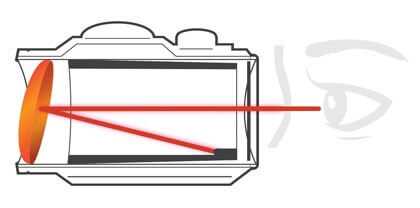
Most red dot sights are “reflex” sights. This means that a spherical mirror allows light from the target to pass through it while reflecting the light emitted from an LED back into the shooter’s eye along a line above and parallel to the barrel. This projects the target image and a dot onto the target in the shooter’s retina.
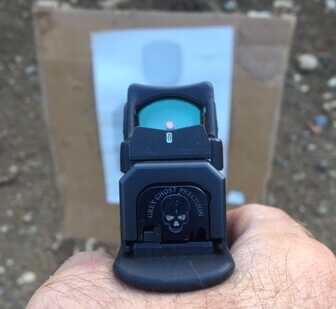
Your eyes can only focus at one distance at a time. Both eyes focus at the same distance. With RDS, the shooter should focus on the target. The dot will appear in the same focal plane as the target. No need for front sight focus or shifting from sights to target. This is the most significant advantage of the dot.
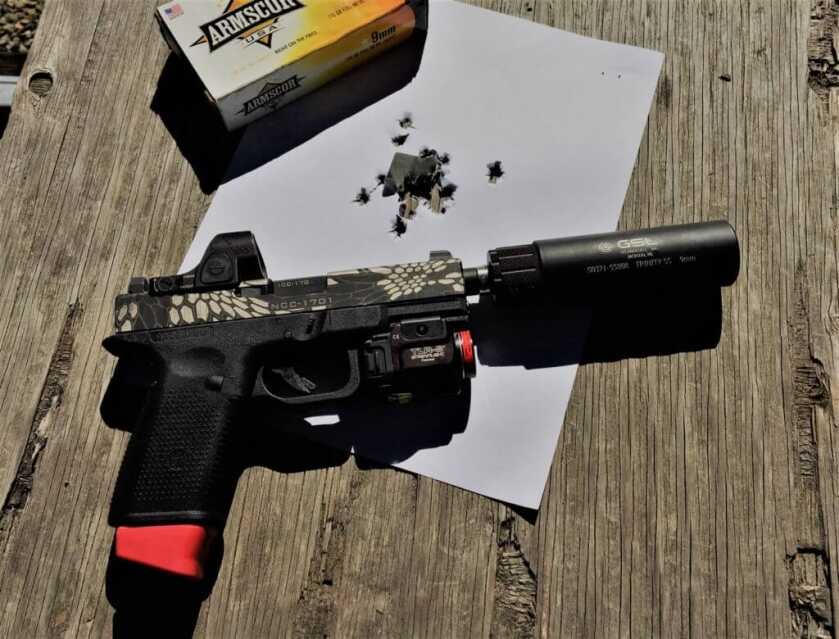
Vision issues provide some of the biggest challenges to shooters. They are difficult to identify and coach because only the shooter can see the image. Some of the issues encountered are near or far sightedness and eye dominance. By allowing both eyes to focus on the target, many vision issues are resolved and shooters gain better awareness of a threat to respond appropriately.
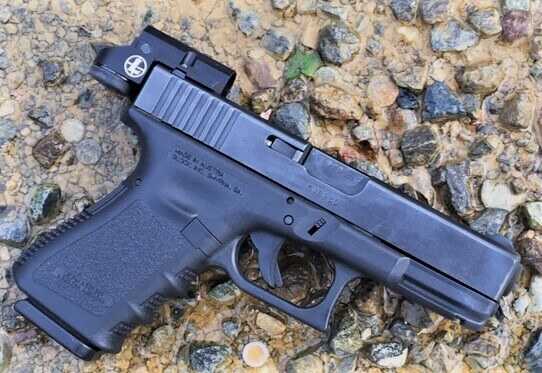
While backup sights can be seen through the RDS window, it is critical to understand that the dot is not aligned with anything else. If sights are co-witnessed, it can be seen in the iron sight picture, but the red dot is not aligned with anything.
The RDS is self collimating. This means that if you can see the dot through any part of the the sight window, the barrel is aligned with the dot and you may take the shot with confidence.
Some instructors teach new RDS shooters to use the backup front sight to find the dot as a crutch. This is the opposite of target-focused shooting and will slow the shooter down. Focus on the target and float the dot over it.
Learning to shoot RDS: Drills and Skills
The first task to accomplish when shooting the RDS is finding the dot. This requires a precise and practiced presentation. Many experienced shooters pick up an RDS pistol and say ” I can’t find the dot”. This is exacerbated by mounting systems which use plates, placing the sights high above the bore.
The solution is to present the handgun in a manner that consistently places the dot between the eye and the target. It will require a number of practice draws to make the presentation precise. Some shooters find a “periscope” move, bringing the sights straight up to the eye from where the hands meet in the draw before pushing out makes finding the dot easier.
The first critical steps in RDS adoption are repeated presentations of the handgun until the shooter consistently sees the dot. Typically, when the dot is unseen, the muzzle is high. Paying close attention to tension in the pinky finger of the shooting hand and the rotation of the wrist in the support hand will help clean this up.
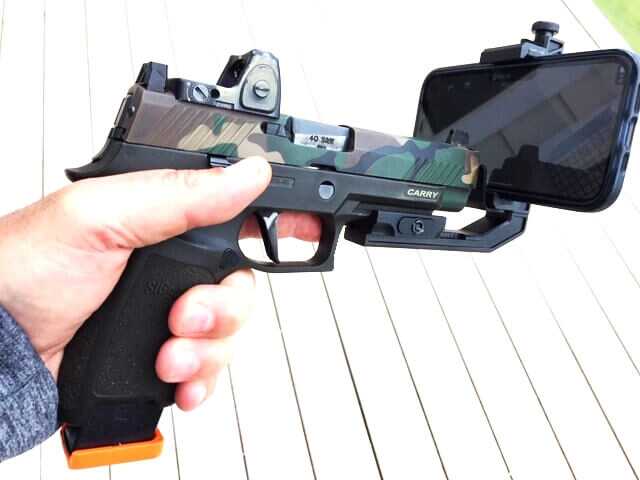
Dry fire presentations from the holster or the ready position are the best way to find the dot. A device such as the Virtual-Shot DryFireMag training magazine can help you get a trigger press without racking the slide each time. They turn boring dry fire into an arcade game.
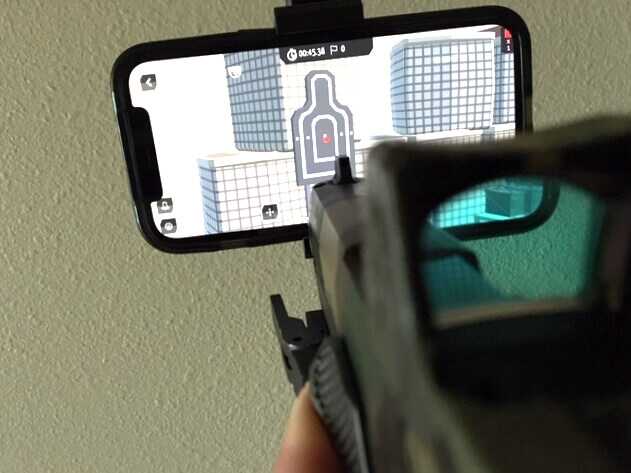
Ammunition and range time are expensive. Fix your draw and presentation five minutes at a time in your living room. Find a target that is visually interesting and focus on it. Draw your pistol and place the dot on the target. If you don’t see the dot, DON’T HUNT FOR IT. Bring the gun back in, fix your grip and head position and try again. Hunting the dot is slow and counter to our goal of proper presentation.
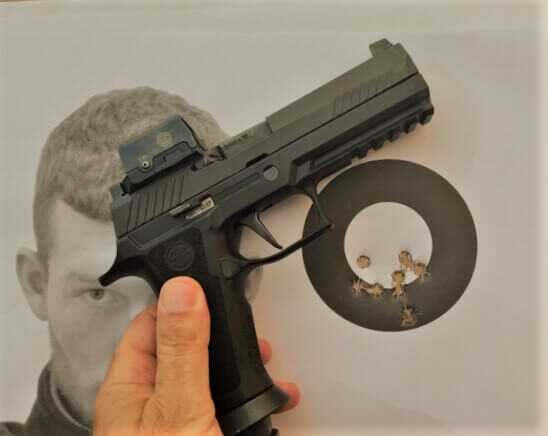
Once you can consistently see the dot, you are ready for the range. How many reps this takes will vary. Experienced shooters will require many repetitions to over-write previous experience. Keep an open mind and practice without self-criticism. You are learning and will not achieve effortless perfection.

Training and Practice
I encourage you to seek out some professional RDS training. I started out self-taught and struggled with improper techniques which slowed my learning. The only thing I did correctly was put in the reps to find the dot before I went to a class. Many instructors have not learned RDS themselves and have little to offer you. Beware the instructor with iron sights.
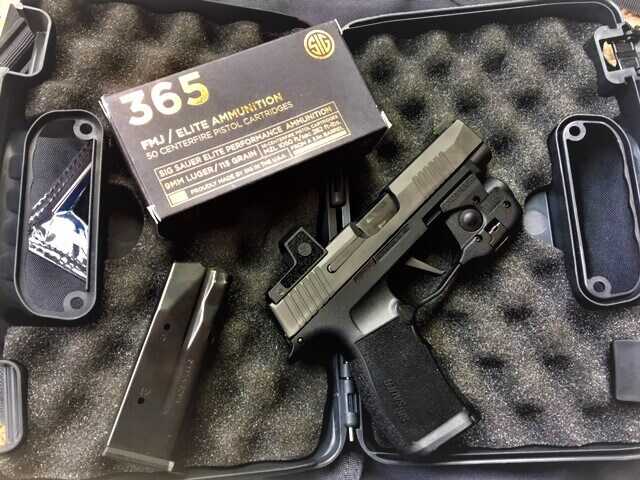
I have been to some great RDS classes from the SIG Academy, NLEFIA, and Willapa Firearms Training. If you don’t have access to classes, I can share a few things I have learned along the way.
- Focus on the target. Float the dot on the target.
- Keep both eyes open and focused on the target.
- In training, shoot at targets small or far away enough to force sight use.
- Practice presentations and target acquisition.
- Practice multiple-target transitions.
- Practice re-loads and malfunctions. Don’t be afraid to use the optic to move the slide.
Zeroing the RDS
To confirm zero: Start at the range with a full-size silhouette target with a one-inch dot in the center of the upper chest at ten yards. Focused on the target, shoot your best three trigger presses.
If you have a spread of more than 10 inches, you can use the adjustments to center the cloud, but don’t waste much time on zero. Work on trigger control and anticipation until you can shoot a group of four inches or less.
Most RDS use a screw adjustment with clicks. Some only have visual adjustments. Most sights have one minute of angle (MOA) adjustments, which means one click moves the impact of the round one-tenth of an inch at ten yards. Five clicks for half an inch. If you are more than three inches off move in increments of 10 clicks and walk it in. Move one adjustment at a time. If your shots are good, you can make rough adjustments off of one round.
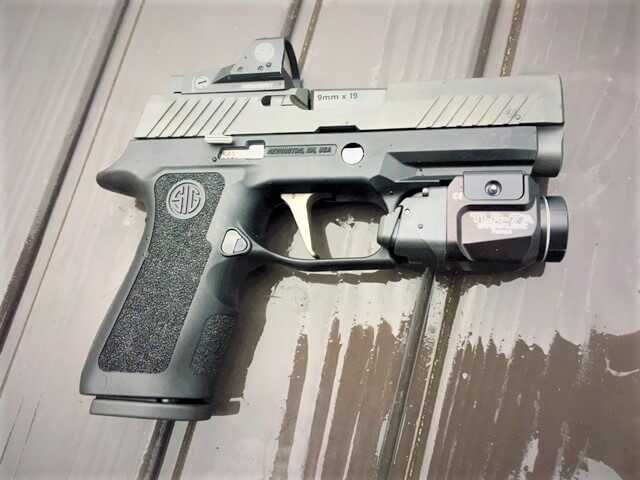
The L-R adjustment moves the impact horizontally. If you hit on the left at 9 o’clock, adjust to the “R” direction.
The U-D adjustment moves the impact vertically. If you hit high at 12 o’clock, adjust to the “D” direction.
When you hit within a few inches of your aiming point, move back to 15 yards and dial it in. If you are struggling (but hitting on the silhouette somewhere), do more shooting and come back to zero when you have a tight group.
A 15 yard zero will drop:
0.2 inches at 25 yards
3.6 inches at 50 yards
8.2 inches at 75 yards
15.1 inches at 100 yards
As your groups improve, you will be able to hit targets at these distances.
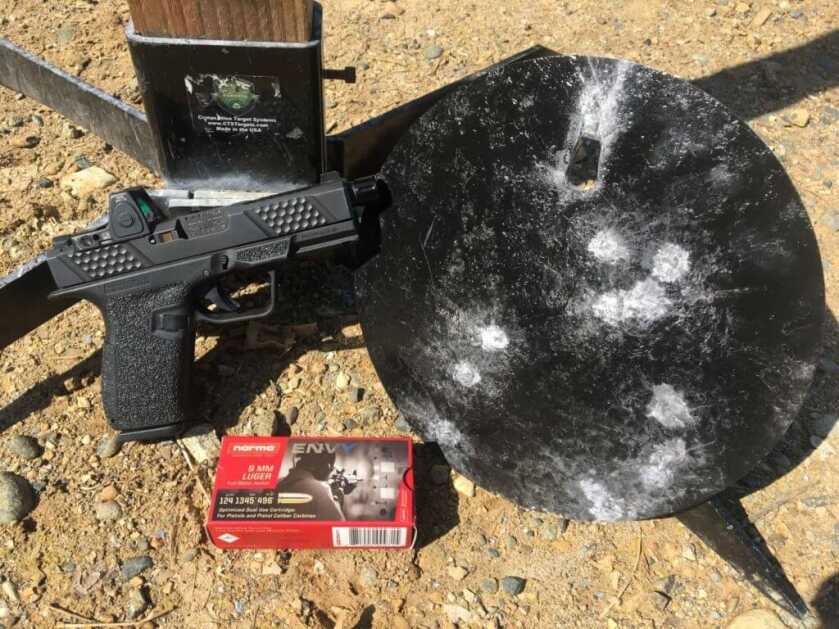
Skills and Drills
A simple assessment drill taught by NLEFIA applies all these skills in six rounds. Target is a 6-inch circle at 7 yards. Start with two three-round magazines, one in the gun, one for re-load. No round in the chamber, gun at low ready.
- Focus on the target, present the gun, see the dot, and press the trigger.
- Perform immediate action, float the dot, take three shots.
- At slide lock, reload, float the dot, take three shots.
Measure your time for self-improvement. If you can’t keep all rounds in the circle, slow down and/or move closer.
If you are having difficulty with target focus or keeping both eyes open, try this drill. Place blue painter’s tape over the front of your optic. This will allow you to see the dot, but not the target with your dominant eye. You will find that both eyes work together to produce the image of the target with a dot on it. This is also a great way to learn how to deal with mud or rain on your optic.
The Way Forward
When you decide to go RDS on your handgun, there is no substitute for dry fire and range practice. New shooters will find red dots intuitive, and their lack of a trained presentation makes learning the dot easier for them. All shooters will find target acquisition and transitions are fast and easy once the presentation is mastered.
RDS lets you see the target and sights better in all light conditions. It allows tracking the sights in recoil to coach improved grip and stance. If you do the work, the RDS will make you faster and safer. What more can you ask?
***Buy and Sell on GunsAmerica! All Local Sales are FREE!***
Photos by Mark Miller except where noted.


Great article, thanks. I just watched a great video by Sig factory pro Daniel Horner. He also stated that bringing the firearm up under the dominant eye with both eyes open and focused on the target and grip is critical to quick red dot acquisition.
Great article
For shooters who trained with iron sights, there are many subtle differences in presentation with RDS.
I am old and wear tri focal glasses. I thought a red dot would be the answer to all my problems. I purchased a S&W performance center Shield Plus with a red dot mounted on it. After several months of trying to get use to it I removed the red dot and now keep the gun as a back up night stand piece. After reading this article I see my mistakes. I am going to remount the red dot and give it another try. Thank you for an informative article.
Thanks for the feedback, Tim. So many people, myself included, try a red dot without getting training or gaining understanding of how they work. The concepts are deceptively simple, but making things work with vision issues can be challenging. Some people make the transition easily but may not get all the advantages of the red dot without some study and training.